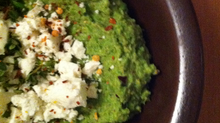Chinese New Year - time for food symbolism!
- twinnydip
- Jan 26, 2014
- 5 min read
Chinese cooking, especially during the new year celebration period is full of food symbolism. We are cooking up a storm - here are how you could impress your guests with some of our delicious recipes. Enjoy!!
Red bean paste pancakes
About the recipe: Red is the colour of good fortune, happiness and joy. That’s why you will see this everywhere during Chinese New Year celebration, from decoration on the wall, to clothes we wear, and food we eat! In this recipe, red is heavily featured – sweetened red bean paste filling is stuffed in Chinese style pancakes (‘bing’).
Ingredients (Makes 5 pancakes)
375g flour
250ml warm water
A pinch of salt
25-35ml vegetable oil, plus more for frying
Salt, to taste
5 tsp sesame seeds (optional)
For the filling
100 – 150g sweetened red bean paste (preferably homemade, I use this recipe http://justonecookbook.com/how-to/how-to-make-anko-red-bean-paste/ or available from Chinese Supermarket)
Direction
1. Sieve flour into a mixing bowl. Add warm water to the flour slowly and mix flour and water to form a smooth dough. (you may not need all of the water). Add a small pinch of salt. Constantly and repeatedly knead and fold and press it down until the dough is really smooth and really elastic. Lightly grease the outer layer of the dough with oil and place it in a bowl. Cover with a damp cloth and let rest for 30 minutes.
2. After sufficiently resting the dough, divide the dough in to 5 equal pieces.
3. On a lightly floured surface – using a rolling pin, roll out one dough piece so that it is approximately 10 x 10 inch in size.
4. Spread evenly 1 – 1.5 tsp of vegetable oil on the dough. Then sprinkle ½ tsp of salt.
5. Starting from one edge of the dough, roll the dough into a long ‘sausage’ shape.
6. Coil the ‘sausage’ up into a ‘cinnamon danish’ shape. Pinch lightly at the end to ensure the oil within is enclosed.
7. Repeat step 4 – 6 for the remaining 4 pieces of pancake dough.
8. Cover each coil with cling film and rest them for approximately 15 minutes.
9. Using a rolling pin, roll each coil out into a 8 - 9 inch diameter pancake.
10. Heat 1 Tbsp vegetable oil in a frying pan over medium to high heat.
11. When the oil is hot, place a pancake in the pan. Sprinkle 1 tsp of sesame seeds on top (optional). Cook for 2 - 3 minutes on one side then flip it over, spread 1/5 of the red bean paste in the centre in a long rectangular shape. Cook for a minute before folding the sides in to enclose the red bean paste. Remove from heat when the pancake is golden brown but not burnt. Keep warm in the oven (preheated to 100C) if desire.
12. Add and heat extra oil to the pan as required (you may not need this). Repeat step 11 for the rest of the pancakes.
13. Serve with hot tea for dessert!
Tang Yuan (Glutinous rice balls)
About the recipe: Chinese new year is nearing, and food symbolism is everywhere. Tang Yuan, glutinous rice balls, are small sweet dumplings made of a glutinous rice flour dough, filled with sesame paste, red bean paste, or peanut paste etc. The round shape of these dumplings symbolise family togetherness; furthermore as the name suggests, these rice balls are glutinous and sticky, just like family should stick together. Traditionally, Tang yuan is consumed on Yuanxiao, the first full moon of the new year. However in our family we always have it right after the new year countdown, as our family gathers for the first time in the new year. Here is a very simple recipe (it takes less than an hour!), we hope you will like it!
Ingredients (makes 24)
For the filling
100g peanuts / sesame / nut of your choice, toasted and grounded
50g sugar
4 Tbsp lard / butter, melted
For the dumpling dough
225g glutinous rice flour
2 Tbsp rice flour / tapioca starch
150ml lukewarm water
Coating (optional)
50 desiccated coconut / toasted sesame
Direction
To prepare the filling, melt lard / butter over low to medium heat. Transfer the lard / butter into a small bowl, and mix it with sugar and ground nuts. Place the mixture into the fridge for 30-45 minutes, or the freezer for a few minutes.
To prepare the dough, mix the glutinous rice flour, rice flour / tapioca starch and water to make a soft dough. Divide the dough into two equal portions. On a surface dusted with rice flour, roll half of the dough into a cylinder about 1.5 inches thick and cut the dough into 12 pieces. Roll the other half dough in the same manner into 12 further pieces of small dough.
Divide the chilled filling into 24 portions. Take a piece of dough and flatten it with your thumb, making an indent in the middle. Place the stuffing into the indent. Seal the opening carefully, making sure the filling does not come out. Gently roll the dough into a ball. Repeat the same with the other dough.
In a pot of boiling water, cook the rice balls until they are floating on the surface and the skins are almost translucent.
Quickly transfer the dumplings into a bowl of desiccated coconut / toasted sesame to coat, or serve in a ginger soup*.
*To prepare a ginger soup, simply boil 5 inches of sliced ginger and 3-4 Tbsp brown sugar in 1000ml water).
Siu yok (Crispy roasted pork)
About this recipe: When we were kids, meat was not a regular dish as it was expensive. Chinese New Year dinner is the one meal a year, when we were allowed to indulge ourselves with dishes from braised beef shin to steamed chicken to the crispy pork belly. Usually crispy pork belly are bought from siu mei shops, where you can get all sorts of roasted meat. Without a siu mei shop nearby since we moved to the UK some ten years ago, we attempted to make this dish from scratch. The outcome was a pleasant surprise – with the juicy fat sandwiched between tender meat and crispy skin. This has now become an annual tradition at our home!
Ingredients
500g pork belly
1 tsp Shaoxing wine
2 tsp salt
1 tsp sugar
1 tsp five-spice powder
1/2 tsp ginger powder
1 tsp white pepper powder
Direction
Rinse the pork belly thoroughly. Cook the pork belly in boiling water for approximately 15 minutes. The skin should be softened after boiling. Drain well and wipe off any water.
Using the tip of a knife make slits on the surface of the skin, be careful not to cut into the meat.
Rub wine evenly on the surface, let rest. In the mean time, combine salt, sugar, five-spice powder, ginger powder and white pepper powder to make the seasoning.
Coat the meat (but not the skin) with the seasoning evenly. Wrap the meat (again not the skin) with foil and place it on a plate. Refrigerate overnight to marinate.
Remove pork from the fridge and remove foil. Let rest at room temperature for 30 minutes. Preheat the oven to 200C.
Poke the skin with needles evenly, so that when cooking the hot fat from beneath will reach the skin and make it crisp. If there is any water on the surface, wipe dry. Sprinkle a pinch of rock salt on the skin.
Bake the pork belly for approximately 45 minutes at 200 oC. Then, increase temperature to 220 oC, and bake for another 10-15 minutes, or until the skin is crispy.



































Comments